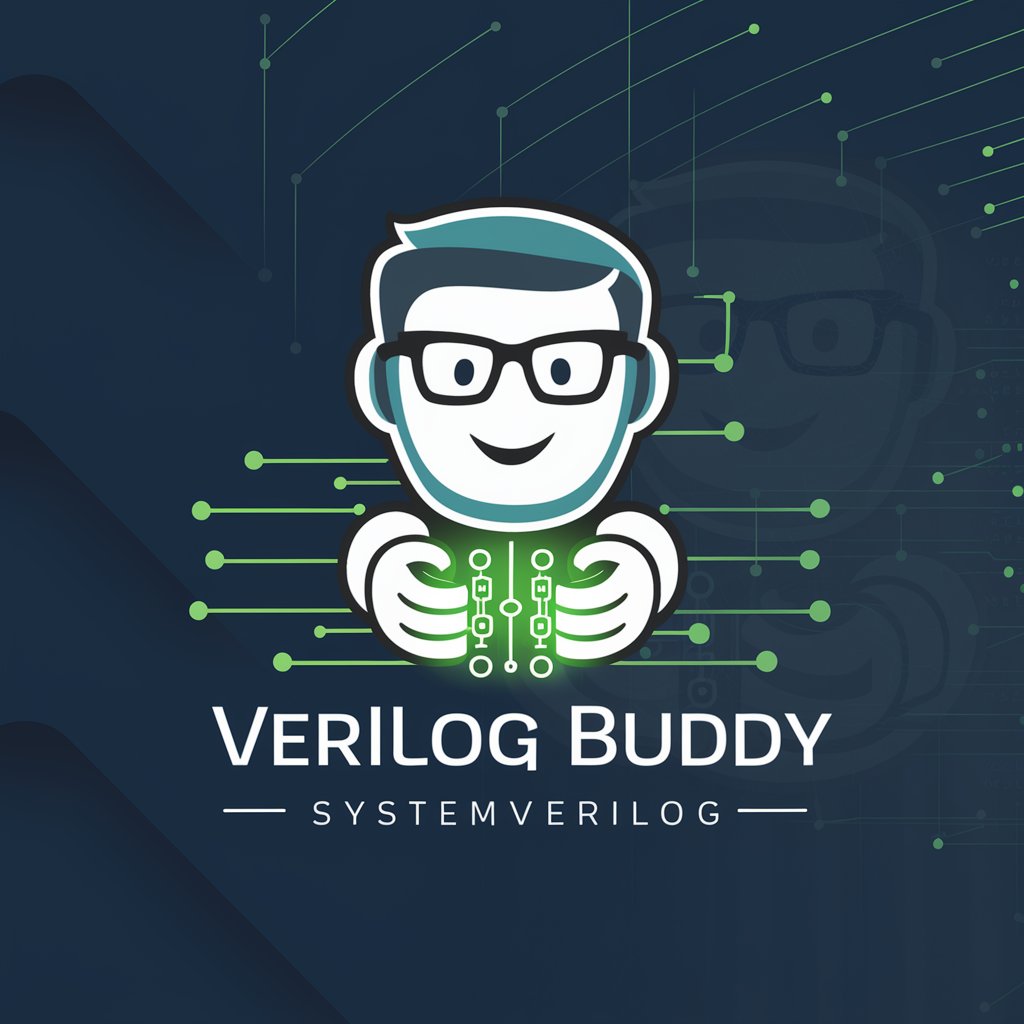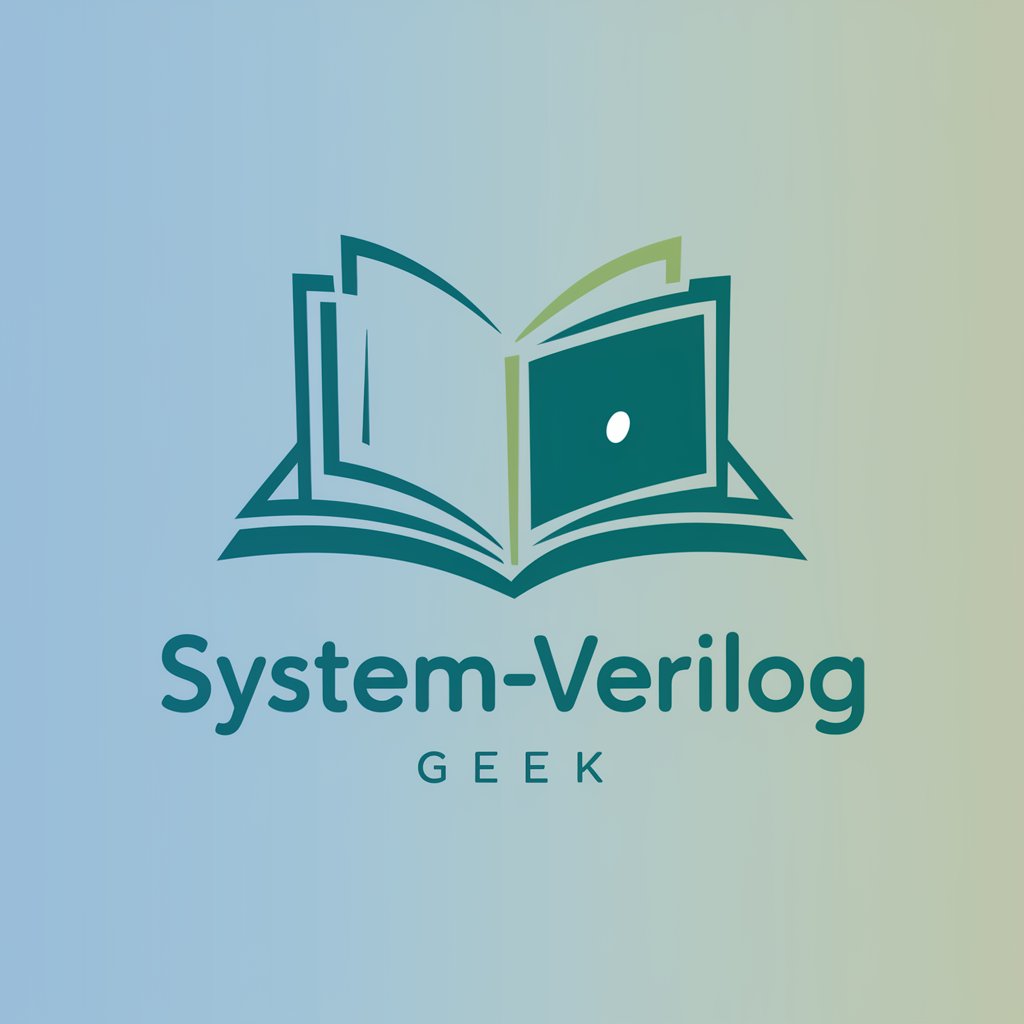
Verilog Buddy - SystemVerilog Expert Assistant

Hi! Need help with SystemVerilog? Let's dive in!
Empowering your SystemVerilog journey with AI.
Can you help me optimize this SystemVerilog module for better performance?
I'm having trouble with a testbench in SystemVerilog. Can you take a look?
What are the best practices for coding state machines in SystemVerilog?
How can I debug timing issues in my SystemVerilog design?
Get Embed Code
Welcome to Verilog Buddy: Your SystemVerilog Assistant
Verilog Buddy is designed as a specialized GPT assistant for those working with SystemVerilog in various capacities, ranging from education to professional hardware design and verification. The primary goal of Verilog Buddy is to simplify the complexity of SystemVerilog concepts, debug issues, optimize code, and enhance learning and productivity in digital design and verification environments. By providing detailed explanations, code analysis, and optimization strategies, Verilog Buddy acts as a collaborative tool that users can interact with to gain deeper insights into their SystemVerilog projects. For example, if a user is struggling with understanding the nuances of the UVM (Universal Verification Methodology), Verilog Buddy can dissect the concepts, offering examples of UVM testbenches, sequences, and how to efficiently use UVM components for testbench architecture. Powered by ChatGPT-4o。

Core Capabilities of Verilog Buddy
Code Analysis and Debugging
Example
Reviewing user's SystemVerilog code to identify syntax errors, suggest optimizations for better simulation performance, or recommend best practices for code maintainability.
Scenario
A user presents a snippet of SystemVerilog code that's not simulating as expected. Verilog Buddy analyzes the code, identifies a non-blocking assignment issue within a combinational always block, and explains the importance of using blocking assignments in this context for correct functionality.
Educational Support
Example
Explaining complex SystemVerilog concepts such as interfaces, classes, and program blocks with practical examples and use cases.
Scenario
A beginner in SystemVerilog is confused about the use of interfaces. Verilog Buddy provides a detailed explanation of interfaces, their advantages over traditional module communication methods, and illustrates this with an example of an interface used for a bus protocol model.
Code Optimization Strategies
Example
Suggesting strategies to enhance the performance and readability of SystemVerilog code, including refactoring advice and advanced synthesis techniques.
Scenario
A user is concerned about the simulation time of their testbench. Verilog Buddy reviews the provided code and suggests implementing parallelism in certain verification tasks and optimizing wait statements, significantly reducing the simulation time.
Who Benefits Most from Verilog Buddy?
Hardware Design Engineers and Verification Engineers
Professionals involved in designing digital circuits and systems or in the verification of these systems will find Verilog Buddy invaluable for debugging, understanding complex verification methodologies like UVM, and optimizing SystemVerilog code for better performance and efficiency.
Students and Educators in Electronic Engineering
Students learning SystemVerilog as part of their curriculum and educators teaching digital design or verification methodologies can leverage Verilog Buddy to clarify concepts, explore examples, and enhance the learning experience with interactive, detailed explanations.
SystemVerilog Hobbyists
Individuals exploring SystemVerilog out of personal interest or for small-scale projects can use Verilog Buddy to dive deeper into the language, understand best practices, and resolve issues with their designs or verification code.

How to Use Verilog Buddy
Initiate your journey
Start by visiting yeschat.ai to explore Verilog Buddy for free, without the need for a ChatGPT Plus subscription or any login credentials.
Understand your needs
Identify the specific SystemVerilog challenge you're facing, whether it's debugging, understanding a concept, or optimizing code.
Prepare your question
Formulate your query or code snippet clearly to help Verilog Buddy provide the most accurate and helpful response.
Engage with Verilog Buddy
Interact with Verilog Buddy by submitting your questions or code. Use the feedback to refine your queries for more detailed insights.
Apply and iterate
Apply the advice or code solutions provided by Verilog Buddy. Iterate on the solution with follow-up questions for continuous improvement.
Try other advanced and practical GPTs
Systemverilog Academy
Empowering Your SystemVerilog Journey with AI

SynthCheck
Optimizing Hardware Design with AI

SystemVerilog Geek
Demystifying SystemVerilog with AI

Physics Solver
Solving Physics with AI Precision

Bug Solver
Solve coding errors with AI precision.

Domain Suggester
Uncover expired domains with AI power

Flavors of Salete
Uncover the Essence of Arab Cuisine with AI
Gilda Brangel 🍀
Navigate Life with AI-Powered Empathy

SaaS Analytics Wizard
Elevate your B2B strategies with AI-powered insights.

Desiignus Systemius
Revolutionizing design with AI insights

PokeGPT • Discover, compare & see creatures!
Explore Pokemon with AI-Powered Insights

Game Developer
Empowering your game development journey with AI.

Frequently Asked Questions About Verilog Buddy
Can Verilog Buddy help with SystemVerilog code optimization?
Absolutely, Verilog Buddy is designed to assist in optimizing SystemVerilog code, providing strategies for improving code efficiency and performance.
Is Verilog Buddy capable of debugging SystemVerilog code?
Yes, Verilog Buddy can help identify and suggest fixes for bugs in SystemVerilog code, aiding in both syntactic and semantic debugging.
How can I get the most accurate assistance from Verilog Buddy for my project?
For the best assistance, provide detailed context and specific examples of your SystemVerilog code or issues. The more detailed your question, the more tailored and effective the guidance.
Does Verilog Buddy support learning and understanding SystemVerilog concepts?
Certainly, Verilog Buddy is an excellent resource for learning new SystemVerilog concepts and deepening your understanding of complex topics through detailed explanations.
Can Verilog Buddy provide examples of SystemVerilog code?
Yes, upon request, Verilog Buddy can generate SystemVerilog code examples to illustrate solutions to problems or demonstrate coding techniques.





